I/C FLIGHT GUIDELINES
Made in Vietnam
When ready to fly, first extend the
transmitter aerial.
Operate the control sticks on the
transmitter and check that the control
surfaces move freely and in the
CORRECT directions.
ALWAYS land the model INTO the
wind, this ensures that the model lands
at the slowest possible speed.
Switch on the transmitter.
Switch off the transmitter.
Check that the transmitter batteries
have adequate power.
Switch off the receiver.
Switch on the receiver.
ALWAYS take off into the wind.
Check that the wings are correctly
fitted to the fuselage.
If the model does not respond correctly
to the controls, land it as soon as
possible and correct the fault.
Empty the fuel tank after flying, fuel left
in the tank can cause corrosion and
lead to engine problems.
14
FLIGHT PREPARATION
PRE FLIGHT CHECK
1. Completely charge your transmitter and receiver
batteries before your first day of flying.
2. Check every bolt and every glue joint in your
plane to ensure that everything is tight and well
bonded.
3. Double check the balance of the airplane
4. Check the control surface
5. Check the receiver antenna. It should be fully
extended and not coiled up inside the fuselage.
6. Properly balance the propeller.
We wish you many enjoyable flights with your
plane and once again thank you for your
choosing a Phoenix Model's products.
MXS size .46-.55
Instruction Manual
MOUNTING THE COWL
1. Remove the muffler and needle valve assembly
from the engine. Slide the fiberglass cowl over
the engine.
2. Measure and mark the locations to be cut out
for engine head clearance, needle valve,
muffler. Remove the cowl and make these
cutouts using a rotary tool with a cutting disc
and a rotary sanding drum attachment.
11
MXS size .46-.55
Instruction Manual
3. Slide the adjustable metal connector / servo
arm assembly over the plain end of the
pushrod wire. Position the throttle stick and the
throttle trim at their lowest positions.
4. Manually push the carburator barrel fully
closed. Angle the arm back about 45 degree
from center and attach the servo arm onto the
servo. With the carburator barrel fully closed,
tighte the set screw in the adjustable metal
connector.
5. Remove the excess throttle pushrod wire using
wire cutters and install the servo arm retaining
screw.
INSTALLING THE THROTTLE
1. Install one adjustable metal connector through
the third hole out from the center of one servo
arm, enlarge the hole in the servo arm using a
2mm drill bit to accommodate the servo
connector. Remove the excess material from
the arm.
!
After installing the adjustable metal connector
apply a small drop of thin C/A to the bottom
nut. This will prevent the connector from
loosening during flight.
2. Plug the throttle servo into the receiver and turn
on the radio system. Check to ensure that the
throttle servo output shaft is moving in the
correct direction. When the throttle stick is
moved forward from idle to full throttle, the
throttle barrel should also open and close using
this motion. If not, reverse the direction of the
servo, using the transmitter.
51
Throttle rod
49
Rudder rod
50
Rudder rod
7. Attach clevis to the third hole in the control
horn. Install a silicone tube on the clevis.
8. Locate one nylon servo arm, and using wire
cutters, remove all but one of the arms using a
2mm drill bit, enlarge the third hole out from the
center to accommodate the rudder pushrod
wire.
9. Plug the rudder servo into the receiver and
center the servo. Install the servo arm onto the
servo.
10. Center the rudder and hold it in place using a
piece of masking tape.
11. With the rudder and rudder servo centered,
carefully place a mark on the rudder pushrod
wire where it crosses the hole in the servo arm.
12. Using a pliers, carefully make a 90 degree
bend up at the mark made. Cut off excess wire,
leaving about 8mm beyond the bend.
13. Insert the 90 degree bend up through the hole
in the servo arm. Install one nylon snap keeper
over the wire to secure it to the arm. Install the
servo arm retaining screw and remove the
masking tape from the rudder.
14.Using thick CA glue, secure the pushrod
sleeves to the pushrod sleeve guide.
25
26
6
1. Tail wheel set
2. Install the tail wheel
TAIL WHEEL INSTALLATION
MXS size .46-.55
Instruction Manual
3. Using a modeling knife, carefully cut out two line
from the margin of the hole onto the wheel pant.
Just cut only one side of the wheel pant, where
the main gear will install. Be sure to make a left
and right wheel pant.
4. Slide a 4.5mm nut/ two 16mm flat washers /
4.5mm nut / collar / wheel / collar onto the axle.
5. Slide the axle assembly into the wheel pant.
There are just one nut and two flat washers
outside of the wheel pant.
6. Remove one nut, one flat washer. Attach the
main landing gear to the axle.
7. Center both collars and wheel in the middle of
the wheel pant, lock both collars in place using
a hexagon 2mm screw.
8. With the landing gear in place, tighten two nuts.
!
Drill
Cut
29
INSTALLING THE WHEEL PANTS
1. Locate the wheel pants from the hardware bag.
Mark the locations of the mounting axles onto
the wheel pants. The locations of the two
mounting holes are the middle of the wheel
opening, on right side, left side and 10mm from
the bottom of the wheel pant.
2. Using a 5mm drill bit, carefully drill two pilot
holes through the wheel pant at the TWO
marks you made.
30
16mm flat washer
MAIN GEAR INSTALLATION
INSTALLING THE MAIN LANDING GEAR
1. Four nuts have been installed at the factory.
2. Install main landing gear into the fuselage using
(4) 4mm x 25mm machine screws and 16mm
flat washers provided in the kit.
27
Remove the covering
28
Screw
Screw
10
MXS size .46-.55
Instruction Manual
44
7. Attach clevis to the third hole in the control
horn. Install a silicone tube on the clevis.
45
Control horn elevator
46
Metal domino
8. Locate one nylon servo arm, and using wire
cutters, remove all but one of the arms. Using a
2mm drill bit, enlarge the third hole out from the
center to accommodate the elevator pushrod
wire.
9. Plug the elevator servo into the receiver and
center the servo. Install the servo arm onto the
servo. The servo arm should be perpendicular
to the servo and point toward the middle of the
fuselage.
10. Be sure both elevator halves are flat. Center
both elevator halves and hold them in place
using a couple of pieces of masking tape.
11. Connect two elevator purshord to the metal
domino connector and secure it. Insert the wire
pushrod into the metal domino connector and
secure it.
12. With the elevator halves and elevator servo
centered, carefully place a mark on the elevator
pushrod wire where it crosses the hole in the
servo arm.
13. Using pliers, carefully make a 90 degree bend
up at the mark made. Cut off the excess wire,
leaving about 8mm beyond the bend.
14. Insert the 90 degree bend up through the hole
in the servo arm, install one nylon snap keeper
over the wire to secure it to the arm. Install the
servo arm retaining screw and remove the
masking tape the elevator halves.
15. Using thick CA glue, secure the pushrod
sleeves to the pushrod sleeve guide.
6. Drill two holes through the rudder using the
control horn as a guide and screw the control
horn in place.
INSTALLING THE RUDDER PUSHROD
1. Locate the pushrod exit slot on the left of the
fuselage.
2. Carefully cut away the covering material from
the slot.
3. Working from inside the fuselage, slide the
threaded end of the remaining pushrod down
the inside of the fuselage until the pushrod
reaches the exit slot. Carefully reach in with a
small screw driver and guide the pushrod out of
the exit slot.
4. Install the clevis on the rudder pushrod. Make
sure 6mm of thread shows inside the clevis.
5. The control horn should be mounted on the
right side of the rudder at the leading edge, in
line with the rudder pushrod.
48
47
Elevator rod
Remove the covering
Silicone
5
VERTICAL STABILIZER INSTALLATION
1. Using a modeling knife, remove the covering on
the top of the fuselage for the vertical stabilizer.
2. Slide the vertical stabilizer into the slot in the
mounting platform in the top of the fuselage.
Mark the shape of the fuselage on the left and
right sides of the vertical stabilizer using a
felt-tip pen.
3. Now, remove the vertical stabilizer and using a
modeling knife, carefully cut just inside the
marked lines and remove the film on both sides
of the vertical stabilizer. Just as you did with the
horizontal stabilizer, make sure you only press
hard enough to cut the film, not the balsa
vertical stabilizer.
4. Slide the vertical stabilizer back in place. Using
a triangle, check to ensure that the vertical
stabilizer is aligned 90 degree to the horizontal
stabilizer.
5. When you are sure that everything is a aligned
correctly, mix up a generous amount of 30
minute epoxy. Apply a thin layer to the slot in
the mounting platform and to the vertical
stabilizer mounting area. Apply epoxy to the
lower rudder hinge. Set the stabilizer in place
and re-align. Double check all of your
measurements once more before the epoxy
cures. Remove any excess epoxy using a
paper towel and rubbing alcohol and hold the
stabilizer in place with T-pins or masking tape.
Allow the epoxy to fully cure before proceeding.
19
Remove
the covering
20
Glue with epoxy
23
Glue with epoxy
24
Remove the covering
21
Hinge
22
MXS size .46-.55
Instruction Manual
8. Installing the rudder using C.A glue as installing
the aileron.
13
Ailerons : 8mm up 8mm down
Elevator : 8mm up 8mm down
Rudder : 25mm right 25mm left
6. If one side of the wing falls, that side is heavier
than the opposite. Add small amounts of lead
weight to the bottom side of the lighter wing
half's wing tip. Follow this procedure until the
wing stays level when you lift the airplane.
!
LATERAL BALANCE
After you have balanced a plane on the C.G.
You should laterally balance it. Doing this will
help the airplane track straighter.
5. Turn the airplane upside down. Attach one loop
of heavy string to the engine crankshaft and
one to the tail wheel wire. With the wings level,
carefully lift the airplane by the string. This may
require two people to make it easier.
CONTROL THROWS
1. We highly recommend setting up a plane using
the control throws listed.
2. The control throws should be measured at the
widest point of each surface!.
3. Check to be sure the control surfaces move in
the correct directions.
Elevator Control
Aileron Control
8mm
8mm
Rudder Control
25mm
25mm
8mm
8mm
MXS size .46-.55
Instruction Manual
90mm
MXS size .46-.55
Instruction Manual
SPECIFICATION
- Wingspan: 1472mm (57.9 in)
- Length: 1335mm (52.5 in)
- Flying weight: 2800-3000 gr
- Wing area: 38.5 dm2
- Wing loading: 76g/dm2
- Wing type: Naca airfoils
- Covering type: Genuine ORACOVER®
- Gear type: Aluminum Hi-grade for main
gear and spring wire for tail gear (included)
- Spinner size: Plastic 58mm (included)
- Radio: 4 channel minimum (not included)
- Servo: 5 standard servo: 2 aileron;
1 elevator; 1 rudder; 1 throttle (not included)
- Recommended receiver battery:
4.8-6V / 800-1200mAh NiMH (not included)
- Servo mount: 21mm x 42 mm
- Propeller: suit with your engine
- Engine: .46-.55 / 2-stroke or .52/4-stroke
glow engine (not included)
- Motor: brushless outrunner 1000-1400 W,
480 KV (not included)
- Gravity CG: 90 mm (3.5 in) Back from the
leading edge of the wing, at the fuselage
- Control throw Ailerons: Low: 8mm up/down,
10% expo; High: 10mm up/down, 10% expo
- Control throw Elevators: Low: 8mm up/down,
12% expo; High: 10mm up/down, 12% expo
- Control throw Rudder: Low: 25mm right/left,
15% expo; High: 40mm right/left, 15% expo
- Experience level: Intermediate
- Plane type: Scale Aerobatic
RECOMMENDED MOTOR AND BATTERY SET UP
- Motor: RIMFIRE .46-.55 (not included)
- Lipo cell: 6 cells / 4000 – 5500mAh (not included)
- Esc: 50-80A (not included)
M X S
GP/EP size .46-.55 SCALE 1:5 ARF
3. Place the servo into the servo tray. Center the
servo within the tray and drill 1,6mm pilot holes
through the block of wood for each of the four
mounting screws provided with the servo.
Remove the covering
3
INSTALLING THE AILERON SERVOS
1. Install the rubber grommets and brass eyelets
onto the aileron servo.
2. Using a modeling knife, remove the covering
from over the pre-cut servo arm exit hole on the
aileron servo tray / hatch. This hole will allow
the servo arm to pass through when installing
the aileron pushrods.
4
6. Repeat step # 2 - # 5 to install the second
aileron servo in the opposite wing half.
5. Place the aileron servo tray / hatch into the
servo box on the bottom of the wing and drill
1,6mm pilot holes through the tray and the
servo box for each of the four mounting screws.
Secure the servo tray in place using the
mounting screws provided ( 2mm x 12mm ).
4. Using the thread as a guide and using masking
tape, tape the servo lead to the end of the
thread: carefully pull the thread out. When you
have pulled the servo lead out, remove the
masking tape and the servo lead from the
thread.
Servo lead
5
6
To the cowl
7
To the cowl
2
MXS size .46-.55
Instruction Manual
8
INSTALLING THE CONTROL HORNS
1. One aileron control horn in positioned on each
aileron. Using a ruler and a pen, locate and
mark the location of the control horn. It should
be mounted on the bottom side of the aileron at
the leading edge, in line with the aileron
pushrod.
2. Drill two 1.6mm holes through the aileron using
the control horn as a guide and screw the
control horn in place.
8
MXS size .46-.55
Instruction Manual
36
35
Screw
5. Test fit the stopper assembly into the tank. It
may be necessary to remove some of the
flashing around the tank opening using a
modeling knife. If flashing is present, make
sure none of it falls into the tank.
6. When satisfied with the alignment of the stopper
assembly tighten the 3mm x 20mm machine
screw until the rubber stopper expands and
seals the tank opening. Do not over tighten the
assembly as this could cause the tank to split.
7. Using a modeling knife, cut 3 lengths of fuel line
150mm long. Connect 2 lines to the 2 vent
tubes and 1 line to the fuel pickup tube in the
stopper.
!
When the stopper assembly is installed in the
tank, the top of the vent tube should rest just
below the top surface of the tank. It should not
touch the top of the tank.
FUEL TANK installation
INSTALLING THE STOPPER ASSEMBLY
1. The stopper has been pre-assembled at the
factory.
2. Using a modeling knife, cut one length of silicon
fuel line (the length of silicon fuel line is
calculated by how the weighted clunk should
rest about 5mm away from the rear of the tank
and move freely inside the tank). Connect one
end of the line to the weighted clunk and the
other end to the nylon pick up tube in the
stopper.
3. Carefully bend the second nylon tube up at a 45
degree angle (using a cigarette lighter). This
tube will be the vent tube to the muffler.
4. Carefully bend the third nylon tube down at a 45
degree angle (using a cigarette lighter). This
tube will be vent tube to the fueling valve.
37
ESC
38
Battery
Atter confirming the direction (see
front view of fuel tank). Insert and
tighten the screw.
5mm
7
MXS size .46-.55
Instruction Manual
!
After installing the wheel pant, apply a small
drop of thin C/A to the bottom nut.
9. Repeat step # 1-8 to install the second wheel
pant assembly.
INSTALLING THE MOTOR AND BATTERY
This model can fly with electric, here is our
recommended for set up the system.
- Motor: RIMFIRE .46-55 (not included)
- Lipo cell: 6 cells / 4000 – 5500mAh (not included)
- Esc: 50-80A (not included)
Installing the electric motor
33
60mm
35mm
16mm
34
31
5. Slide the pushrod housing through the hole in
the firewall, through the hole in the forward
bulkhead, and into the servo compartment.
6. Apply a couple of drops of thin C/A to the
pushrod housing where it exits the firewall and
where it passes through the forward bulkhead.
This will secure the housing in place.
7. Using a modeling knife, cut off the nylon
pushrod housing in front of the servo tray.
INSTALLING THE ENGINE
Locate the long piece of wire used for the throttle
pushrod. One end of the wire has been
pre-bend in to a "Z" bend at the factory. This
"Z" bend should be inserted into the throttle
arm of the engine when the engine is fitted
onto the engine mount. Fit the engine to the
engine mount using the screws provided.
2. Place the engine into the engine mount and
align it properly with the front of the cowling.
The distance from the firewall to the front of the
engine thrust washer should 100-110mm.
If your engine is equipped with a remote needle
valve, we suggest installing it into the engine at
this time.
3. When satisfied with the alignment of the engine,
use a pencil and mark the mounting hole
location onto the firewall, where the throttle
pushrod will exit.
4. Now, remove the engine. Using a 5mm drill bit,
drill holes through the firewall and the forward
bulkhead at the marks made.
!
ENGINE INSTALLATION
INSTALLING THE THROTTLE PUSHROD HOUSING
1. Install the engine mount.
Screw
32
- OS .46-.55 Two stroke
52
Enlarging the holes through the cowl will prevent
the fiberglass from splitting when the mounting
screws are installed.
6. Slide the cowl back over the engine and secure it
in place using four 3mm x 12mm wood screws.
7. Install the muffler. Connect the fuel and pressure
lines to the carburator, muffler and fuel filler
valve. Tighten the screws completely.
3. Slide the cowl back into place. Align the front of
the cowl with the crankshaft of the engine. The
front of the cowl should be positioned so the
crankshaft is in the middle of the precut
opening. Hold the cowl firmly in place using
several pieces of masking tape.
4. While holding the cowl firmly in position, drill
four 1,6mm pilot holes through both the cowl
and the side edges of the firewall.
5. Using a 3mm drill bit, enlarge the four holes in
the cowling.
53
INSTALLING THE SWITCH
1. The switch should be mounted on the fuselage
side, opposite the muffler, close enough to the
receiver so the lead will reach. Use the face
plate of the switch cut out and locate the
mounting holes.
2. Cut out the switch hole using a modeling knife.
Use a 2mm drill bit and drill out the two
mounting holes through the fuselage side.
3. Secure the switch in place using the two
machine screws provided with the radio system.
54
Cowl area cutout
for proper airflow
to carburetor.
4. If the nose of the plane falls, the plane is nose
heavy. To correct this first move the battery
pack further back in the fuselage, If this is not
possible or does not correct it, stick small
amounts of lead weight on the fuselage under
the horizontal stabilizer. If the tail of the plane
falls, the plane is tail heavy. To correct this,
move the battery and receiver forward or if this
is not possible, stick weight into the firewall.
When balanced correctly, the airplane should
sit level or slightly nose down when you lift it up
with your fingers.
BALANCING
1. It is critical that your airplane be balanced
correctly. Improper balance will cause your
plane to lose control and crash.
THE CENTER OF GRAVITY IS LOCATED 90mm
BACK FROM THE LEADING EDGE OF THE
WING, AT THE FUSELAGE. BALANCE A
PLANE UPSIDE DOWN WITH THE FUEL
TANK EMPTY.
2. Mount the wing to the fuselage. Using a couple
of pieces of masking tape, place them on the
top side of the wing 90mm bach from the
leading edge, at the fuselage sides.
3. Turn the airplane upside down. Place your
fingers on the masking tape and carefully lift
the plane.
INSTALLING THE RECEIVER AND BATTERY
1. Plug the servo leads and the switch lead into
the receiver. You may want to plug an aileron
extension into the receiver to make plugging in
the aileron servo lead easier when you are
installing the wing. Plug the battery pack lead
into the switch.
2. Wrap the receiver and battery pack in the
protective foam to protect them from vibration.
Use a rubber band or masking tape to hold the
foam in place.
12
MXS size .46-.55
Instruction Manual
!
Screw
9
MXS size .46-.55
Instruction Manual
42
41
Elevator servo
Rudder servo
Throttle servo
SERVO INSTALLATION
INSTALLING THE FUSELAGE SERVOS
1. Install the rubber grommets and brass collets
into the elevator, rudder and throttle servos.
Test fit the servos into the servo tray. Trim the
tray if necessary to fit your servos
2. Mount the servos to the tray using the mounting
screws provided with your radio system.
INSTALLING THE ELEVATOR PUSHROD
1. Locate the pushrod exit slot on the right side
and left side of the fuselage. It is located
slightly ahead and below the horizontal
stabilizer.
2. Carefully cut away the covering material from
the slot.
3. Working from inside the fuselage, slide the
threaded end of the pushrod until it reaches the
exit slot. Carefully reach in with a small screw
driver and guide the pushrod out of the exit
slot.
4. Install the clevis on the elevator pushrod. Make
sure 6mm of thread shows inside the clevis.
5. The control horn should be mounted on the
bottom, left side and right side of the elevator at
the leading edge, in line with the elevator
pushrod.
6. Drill two holes through the elevator using the
control horn as a guide and screw the control
horn in place.
43
Control horn elevator
To carburator
To muffler
To vent Tube
40
39
Zip tie
8. Feed three lines through the fuel tank
compartment and through the pre-drilled hole in
the firewall. Pull the lines out from behind the
engine, while guiding the fuel tank into place.
Push the fuel tank as far forward as possible,
the front of the tank should just about touch the
back of the firewall.
Blow through one of the lines to ensure the fuel
lines have not become kinked inside the fuel
tank compartment. Air should flow through
easily.
Do not secure the tank into place permanently
until after balancing the airplane. You may
need to remove the tank to mount the battery in
the fuel tank compartment.
9. Secure the fuel tank.
!
Remove the covering
4
MXS size .46-.55
Instruction Manual
Draw a center line
14
15
17
Glue with epoxy
16
Remove the covering
3. Check the fit of the horizontal stabilizer in its
slot. Make sure the horizontal stabilizer is
square and centered to the fuselage by taking
measurements, but don't glue anything yet.
4. With the horizontal stabilizer correctly aligned,
mark the shape of the fuselage on the top and
bottom of the tail plane using a water soluble /
non-permanent felt-tip pen.
!
When cutting through the covering to remove it,
cut with only enough pressure to only cut
through the covering it's self. Cutting into the
balsa structure may weaken it. This could lead
to possible failure during flight.
5. Remove the stabilizer. Using the lines you just
drew as a guide, carefully remove the covering
from between them using a modeling knife.
2. Draw a center line onto the horizontal stabilizer.
6. When you are sure that everything is aligned
correctly, mix up a generous amount of 30
minute epoxy. Apply a thin layer to the top and
bottom of the stabilizer mounting area and to
the stabilizer mounting platform sides in the
fuselage. Slide the stabilizer in place and
re-align. Double check all of your
measurements one more time before the epoxy
cures. Remove any excess epoxy using a
paper towel and rubbing alcohol and hold the
stabilizer in place with T-pins or masking tape.
7. After the epoxy has fully cured, remove the
masking tape or T-pins used to hold the
stabilizer in place and carefully inspect the glue
joints. Use more epoxy to fill in any gaps that
were not filled previously and clean up the
excess using a paper towel and rubbing alcohol.
8. Installing the elevator using C.A glue as
installing the aileron.
18
C.A glue
3
INSTALLING THE WING TO THE FUSELAGE
Attach the wings to the joiner tube and using the
nylon thumbscrews to secure the wing panels
to the fuselage.
12
Screw
MXS size .46-.55
Instruction Manual
13
HORIZONTAL STABILIZER INSTALLATION
1. Using a modeling knife, cut away the covering
from the fuselage for the stabilizer and remove it.
Remove the
covering
9. Repeat step # 4 - # 8 to install the second
aileron linkage. After both linkages are
completed, connect both of the aileron servo
leads using a Y-harness you have purchased
separately.
11
To the cowl
Silicone Tube
10
3. Repeat step # 1 - # 2 to install the control horn
on the opposite aileron.
2. Attach the clevis to the outer hole in the control
horn. Install a silicone tube on the clevis.
3. Locate one nylon servo arm, and using wire
cutters, remove all but one of the arms. Using a
2mm drill bit, enlarge the third hole out from the
center of the arm to accommodate the aileron
pushrod wire.
4. Plug the aileron servo into the receiver and
center the servo. Install the servo arm onto the
servo. The servo arm should be perpendicular
to the servo and point toward the middle of the
wing.
5. Center the aileron and hold it in place using a
couple of pieces of masking tape.
6. With the aileron and aileron servo centered,
carefully place a mark on the aileron pushrod
wire where it crosses the hole in the servo arm.
7. Using pliers, carefully make a 90 degree bend
down at the mark made. Cut off the excess
wire, leaving about 4mm beyond the bend.
8. Insert the 90 degree bend down through the
hole in the servo arm. Install one nylon snap
keeper over the wire to secure it to the arm.
Install the servo arm retaining screw and
remove the masking tape from the aileron.
INSTALLING THE AILERON LINKAGES
1. Working with the aileron linkage for now, thread
one nylon clevis at least 14 turns onto one of
the 2mm x 180mm threaded wires.
9
RIGHT WRONG
Silicone Tube
Clevis
Metal pushrod
1
TOOLS AND SUPPLIES NEEDED.
• Medium C/A glue
• 30 minute epoxy
• 6 minute epoxy
• Hand or electric drill
• Assorted drill bits
• Modeling knife
• Straight edge ruler
• 2 bender plier
• Wire cutters
• Masking tape
• Thread lock
• Paper towels
• Rubbing alcohol
SUGGESTION
To avoid scratching your new airplane, do not unwrap
the pieces until they are needed for assembly. Cover
your workbench with an old towel or brown paper,
both to protect the aircraft and to protect the table.
Keep a couple of jars or bowls handy to hold the
small parts after you open the bag.
NOTE:
Please trial fit all the parts. Make sure you have the
correct parts and that they fit and are aligned properly
before gluing! This will assure proper assembly. The
MXS GP/EP size .46-.55 SCALE 1:5 ARF is hand
made from natural materials, every plane is unique
and minor adjustments may have to be made.
However, you should find the fit superior and
assembly simple.
The painted and plastic parts used in this kit are fuel
proof. However, they are not tolerant of many harsh
chemicals including the following: paint thinner, C/A
glue accelerator, C/A glue debonder and acetone. Do
not let these chemicals come in contact with the
colors on the covering and the plastic parts.
SAFETY PRECAUTION:
• This is not a toy
• Be sure that no other flyers are using your radio
frequency.
• Do not smoke near fuel
• Store fuel in a cool, dry place, away from
children and pets.
• Wear safety glasses.
• The glow plug clip must be securely attached to
the glow plug.
• Do not flip the propeller with your fingers.
• Keep loose clothing and wires away from the propeller.
• Do not start the engine if people are near. Do not
stand in line with the side of the propeller.
• Make engine adjustments from behind the propeller
only. Do not reach around the spinning propeller.
PREPARATIONS
Remove the tape and separate the ailerons
from the wing and the elevators from the stab.
Use a covering iron with a covering sock on
high heat to tighten the covering if necessary.
Apply pressure over sheeted areas to
thoroughly bond the covering to the wood.
1
INSTALLING THE AILERONS
1. Test fit the ailerons to the wing with the hinges.
If the hinges don’t remain centered, stick a pin
through the middle of the hinge to hold it in
position.
TEMPORARY PIN
TO KEEP HINGE
CENTERED
2
CA glue
2. Apply six drops of thin CA to the top and bottom
of each hinge. Do not use CA accelerator. After
the CA has fully hardened, test the hinges by
pulling on the aileron.
Instruction Manual
MXS size .46-.55
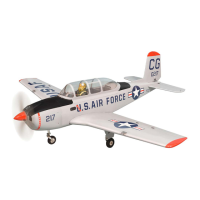
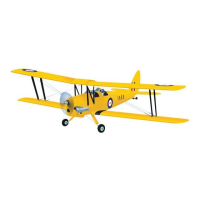

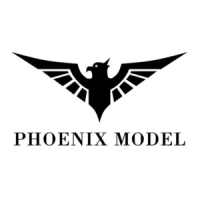
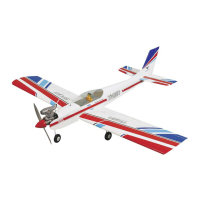
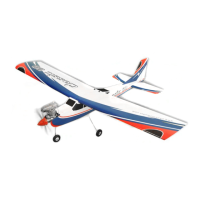
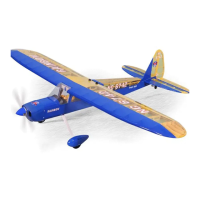
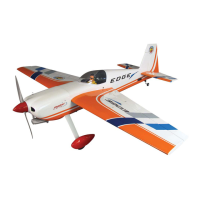
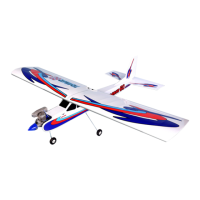

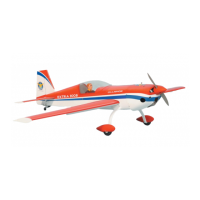
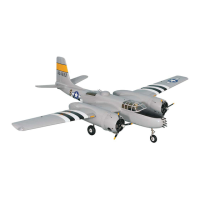
